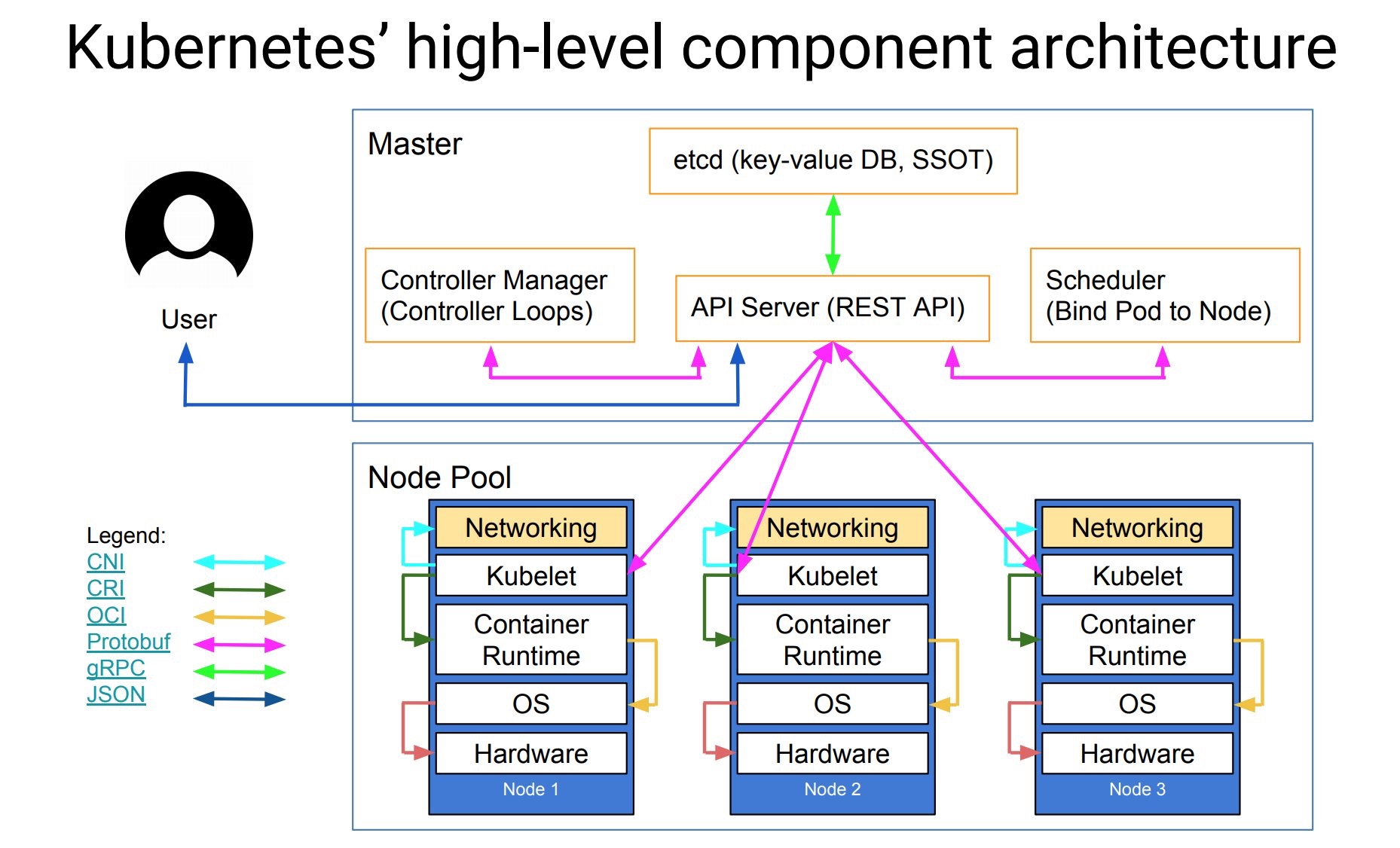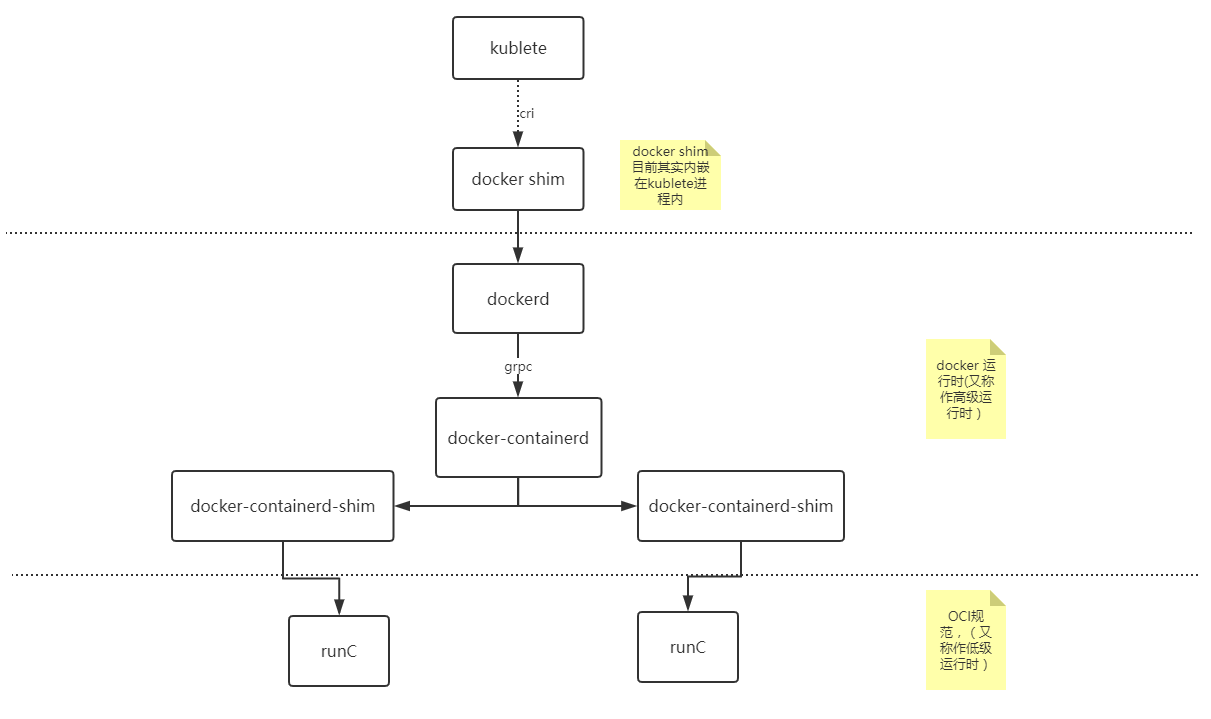kubernetes CRI 前世今生
在学习kubernetes的过程中,我们会遇到CRI、CNI、CSI、OCI 等术语,本文试图先通过分析k8s目前默认的一种容器运行时架构,来帮助我们更好理解k8s 运行时背后设计逻辑。进而引出CRI、OCI的提出背景。
一、k8s 架构
我们在构建k8s集群的时候首先需要搭建master节点、其次需要创建node节点并将node节点加入到k8s集群中。当我们构建好k8s集群后,我们可以通过kubectl create -f nginx.yml 命令的方式来创建应用对应的pod。当我们执行命令
后,命令会提交给API server,它会解析yml文件,并将其以API对象的形式存到 etcd里。这时master组件中的Controller Manager会通过控制循环的方式来做编排工作,创建应用所需要的Pod。Scheduler 会 watch etcd中新Pod 的变化。如
果他发现有一个新的Pod 出现,Scheduler会运行调度算法,通过调度算法最终选择出最佳的Node节点,并将这个Node节点的名字写到pod对象的NodeName字段上面,这一步就是所谓的Bind Pod to Node(下图的标注),然后把bind的结果写回到etcd。
其次,当我们在构建k8s集群的时候,默认每个节点上都会初始化创建一个kubelet进程,kubelet进程的会watch etcd中的pod的变化,当kubelet进程watch到pod的bind的更新操作,并且bind的节点是本节点时,它会接管接下来的
所做的事情,如镜像下载,容器创建等。

二、k8s 默认容器运行时架构
接下来将通过k8s默认集成的容器运行时架构来看kublete如何创建一个容器(如下图所示)。
1. kubelet 通过 CRI(Container Runtime Interface) 接口(gRPC) 调用 dockershim, 请求创建一个容器, 这一步中, Kubelet 可以视作一个简单的 CRI Client, 而 dockershim 就是接收请求的 Server.
2. dockershim 收到请求后, 通过适配的方式,适配成 Docker Daemon 的请求格式, 发到 Docker Daemon 上请求创建一个容器。在docker 1.12后版本中,docker daemon被拆分成dockerd和containerd,containerd负责操作容器。
3. dockerd收到请求后, 调用containerd进程去创建一个容器。
4. containerd 收到请求后, 并不会自己直接去操作容器, 而是创建一个叫做 containerd-shim 的进程, 让 containerd-shim 去操作容器. 创建containered-shim的目的主要有:
1)让containerd-shim做诸如收集状态, 维持 stdin 等 fd 打开等工作.
2)允许容器运行时(runC)启动容器后退出,不必为每个容器一直运行一个容器运行时runC。
3)即使在 containerd 和 dockerd 都挂掉的情况下,容器的标准 IO 和其它的文件描述符也都是可用的。
4)向 containerd 报告容器的退出状态
5)在不中断容器运行的情况下升级或重启 dockerd
5. 而containerd-shim 在这一步需要调用 runC 这个命令行工具, 来启动容器,runC是OCI(Open Container Initiative, 开放容器标准) 的一个参考实现。主要用来设置 namespaces 和 cgroups, 挂载 root filesystem等操作。
6.runC启动完容器后本身会直接退出, containerd-shim 则会成为容器进程的父进程, 负责收集容器进程的状态, 上报给 containerd, 并在容器中 pid 为 1 的进程退出后接管容器中的子进程进行清理, 确保不会出现僵尸进程(关闭进程描述符等)。

三、容器与容器编排背景简述
从k8s的容器运行时可以看出,kubelet启动容器的过程经过了很长的一段调用链路。这个是由于在容器及编排领域各大厂商与docker之间的竞争以及docker公司为了抢占paas领域市场,对架构做出的一系列调整。其实 k8s 最开始
的运行时架构链路调用没有这么复杂: kubelet 想要创建容器直接通过 docker api 调用 Docker Daemon,Docker Daemon 调 libcontainer 这个库来启动容器。为了防止docker垄断以及受控docker运行时, 各大厂商于是就联合起来制定出开
放容器标准OCI(Open Containers Initiative).大家可以基于这个标准开发自己的容器运行时。Docker公司则把 libcontainer做了一层封装, 变成 runC 捐献给CNCF作为 OCI 的参考实现.
接下来就是 Docker 要搞 Swarm 进军 PaaS 市场, 于是做了个架构切分, 把容器操作都移动到一个单独的 Daemon 进程 containerd 中去, 让 Docker Daemon 专门负责上层的封装编排. 最终swarm败给了k8s, 于是
Docker 公司就把 containerd 捐给 CNCF ,专注于搞 Docker 企业版了.
与此同时,容器领域,core os公司推出了个rkt容器运行时。希望 k8s 原生支持 rkt 作为运行时, 由于core os与google的关系,最终rkt运行时的支持在2016年也被合并进kubelet主干代码里. 这样做后反而给k8s中负责维护 kubelet 的小
组 SIG-Node带来了更大的负担,每一次kubelet的更新都要维护docker和rkt两部分代码。与此同时,随着虚拟化技术强隔离容器技术runV(Kata Containers前身,后与intel clear container 合并)的逐渐成熟。k8s上游对虚拟化容器的支持很
快被提上了日程。为了从集成每一种运行时都要维护一份代码中解放出来,k8s SIG-Node工作组决定对容器的操作统一地抽象成一个接口,这样kubelet只需要跟这个接口
打交道,而具体地容器运行时,他们只需要实现该接口,并对kubelet暴露gRPC服务即可。这个统一地抽象地接口就是k8s中俗称的 CRI。
四、CRI(容器运行时接口)
CRI 基于 gRPC 定义了 RuntimeService 和 ImageService 等两个 gRPC 服务,分别用于容器运行时和镜像的管理。如下所示:
// Runtime service defines the public APIs for remote container runtimes
service RuntimeService {
// Version returns the runtime name, runtime version, and runtime API version.
rpc Version(VersionRequest) returns (VersionResponse) {}
// RunPodSandbox creates and starts a pod-level sandbox. Runtimes must ensure
// the sandbox is in the ready state on success.
rpc RunPodSandbox(RunPodSandboxRequest) returns (RunPodSandboxResponse) {}
// StopPodSandbox stops any running process that is part of the sandbox and
// reclaims network resources (e.g., IP addresses) allocated to the sandbox.
// If there are any running containers in the sandbox, they must be forcibly
// terminated.
// This call is idempotent, and must not return an error if all relevant
// resources have already been reclaimed. kubelet will call StopPodSandbox
// at least once before calling RemovePodSandbox. It will also attempt to
// reclaim resources eagerly, as soon as a sandbox is not needed. Hence,
// multiple StopPodSandbox calls are expected.
rpc StopPodSandbox(StopPodSandboxRequest) returns (StopPodSandboxResponse) {}
// RemovePodSandbox removes the sandbox. If there are any running containers
// in the sandbox, they must be forcibly terminated and removed.
// This call is idempotent, and must not return an error if the sandbox has
// already been removed.
rpc RemovePodSandbox(RemovePodSandboxRequest) returns (RemovePodSandboxResponse) {}
// PodSandboxStatus returns the status of the PodSandbox. If the PodSandbox is not
// present, returns an error.
rpc PodSandboxStatus(PodSandboxStatusRequest) returns (PodSandboxStatusResponse) {}
// ListPodSandbox returns a list of PodSandboxes.
rpc ListPodSandbox(ListPodSandboxRequest) returns (ListPodSandboxResponse) {}
// CreateContainer creates a new container in specified PodSandbox
rpc CreateContainer(CreateContainerRequest) returns (CreateContainerResponse) {}
// StartContainer starts the container.
rpc StartContainer(StartContainerRequest) returns (StartContainerResponse) {}
// StopContainer stops a running container with a grace period (i.e., timeout).
// This call is idempotent, and must not return an error if the container has
// already been stopped.
// TODO: what must the runtime do after the grace period is reached?
rpc StopContainer(StopContainerRequest) returns (StopContainerResponse) {}
// RemoveContainer removes the container. If the container is running, the
// container must be forcibly removed.
// This call is idempotent, and must not return an error if the container has
// already been removed.
rpc RemoveContainer(RemoveContainerRequest) returns (RemoveContainerResponse) {}
// ListContainers lists all containers by filters.
rpc ListContainers(ListContainersRequest) returns (ListContainersResponse) {}
// ContainerStatus returns status of the container. If the container is not
// present, returns an error.
rpc ContainerStatus(ContainerStatusRequest) returns (ContainerStatusResponse) {}
// UpdateContainerResources updates ContainerConfig of the container.
rpc UpdateContainerResources(UpdateContainerResourcesRequest) returns (UpdateContainerResourcesResponse) {}
// ReopenContainerLog asks runtime to reopen the stdout/stderr log file
// for the container. This is often called after the log file has been
// rotated. If the container is not running, container runtime can choose
// to either create a new log file and return nil, or return an error.
// Once it returns error, new container log file MUST NOT be created.
rpc ReopenContainerLog(ReopenContainerLogRequest) returns (ReopenContainerLogResponse) {}
// ExecSync runs a command in a container synchronously.
rpc ExecSync(ExecSyncRequest) returns (ExecSyncResponse) {}
// Exec prepares a streaming endpoint to execute a command in the container.
rpc Exec(ExecRequest) returns (ExecResponse) {}
// Attach prepares a streaming endpoint to attach to a running container.
rpc Attach(AttachRequest) returns (AttachResponse) {}
// PortForward prepares a streaming endpoint to forward ports from a PodSandbox.
rpc PortForward(PortForwardRequest) returns (PortForwardResponse) {}
// ContainerStats returns stats of the container. If the container does not
// exist, the call returns an error.
rpc ContainerStats(ContainerStatsRequest) returns (ContainerStatsResponse) {}
// ListContainerStats returns stats of all running containers.
rpc ListContainerStats(ListContainerStatsRequest) returns (ListContainerStatsResponse) {}
// UpdateRuntimeConfig updates the runtime configuration based on the given request.
rpc UpdateRuntimeConfig(UpdateRuntimeConfigRequest) returns (UpdateRuntimeConfigResponse) {}
// Status returns the status of the runtime.
rpc Status(StatusRequest) returns (StatusResponse) {}
}
// ImageService defines the public APIs for managing images.
service ImageService {
// ListImages lists existing images.
rpc ListImages(ListImagesRequest) returns (ListImagesResponse) {}
// ImageStatus returns the status of the image. If the image is not
// present, returns a response with ImageStatusResponse.Image set to
// nil.
rpc ImageStatus(ImageStatusRequest) returns (ImageStatusResponse) {}
// PullImage pulls an image with authentication config.
rpc PullImage(PullImageRequest) returns (PullImageResponse) {}
// RemoveImage removes the image.
// This call is idempotent, and must not return an error if the image has
// already been removed.
rpc RemoveImage(RemoveImageRequest) returns (RemoveImageResponse) {}
// ImageFSInfo returns information of the filesystem that is used to store images.
rpc ImageFsInfo(ImageFsInfoRequest) returns (ImageFsInfoResponse) {}
}
具体容器运行时则需要实现 CRI 定义的接口(即 gRPC server,通常称为 CRI shim)。容器运行时在启动 gRPC server 时需要监听在本地的 Unix Socket (Windows 使用 tcp 格式)。
五、 容器运行时实现
除了上面介绍的默认的容器运行时的实现,目前容器运行时主要有:
- cri-o:同时兼容OCI和CRI的容器运行时
- cri-containerd:基于Containerd的Kubernetes CRI 实现
- rkt:由CoreOS主推的用来跟docker抗衡的容器运行时
- frakti:基于hypervisor的CRI
- Clear Containers:由Intel推出的同时兼容OCI和CRI的容器运行时
- Kata Containers:符合OCI规范同时兼容CRI
- gVisor:由谷歌推出的容器运行时沙箱(Experimental)
参考文档:
https://github.com/kubernetes/cri-api/blob/master/pkg/apis/runtime/v1alpha2/api.proto
https://feisky.gitbooks.io/kubernetes/plugins/CRI.html
https://aleiwu.com/post/cncf-runtime-landscape/
https://www.infoq.cn/article/r*ikOvovTHhADAWw1Hb1





 浙公网安备 33010602011771号
浙公网安备 33010602011771号